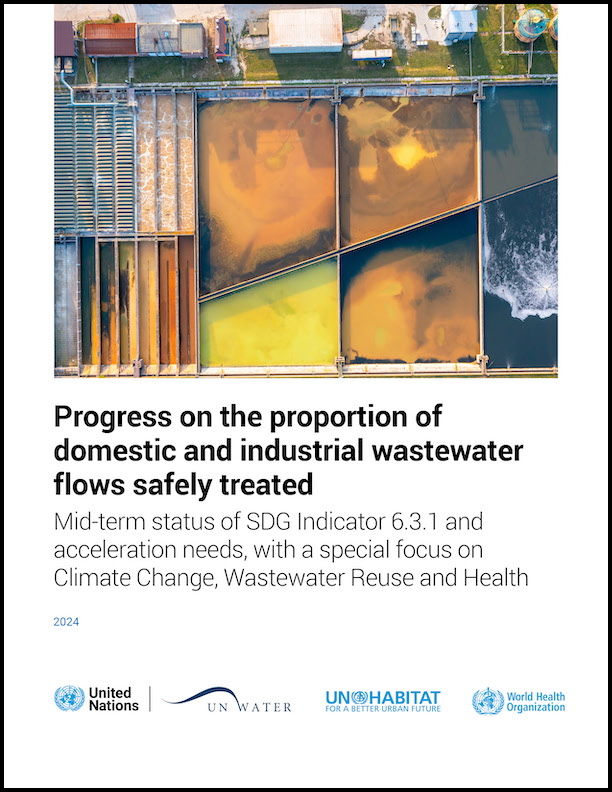Progress on Wastewater Treatment – 2024 Update


Target 6.3 is: “By 2030, improve water quality by reducing pollution, eliminating dumping and minimizing release of hazardous chemicals and materials, halving the proportion of untreated wastewater and substantially increasing recycling and safe reuse globally”.
Indicator 6.3.1 tracks the proportion of total, industrial and household (domestic) wastewater flows safely treated in compliance with national or local standards. The household component includes both sewage and faecal sludge, treated on-site or off-site, with linkages to indicator 6.2.1a on sanitation.
This report presents the global status on wastewater treatment and acceleration needs to achieve target 6.3 by 2030, based on the latest data on indicator 6.3.1 (total wastewater flows as well as flows from industrial sources and households).
Over the 107 countries reporting some wastewater statistics for 2022 (representing 73 per cent of the world’s population) in the present report, the proportion of total wastewater receiving some level of treatment (76 per cent) could only be calculated for 73 countries (representing 42 per cent of the global population); whereas the proportion of total wastewater “safely” (i.e. at least secondary treatment) treated (60 per cent) could only be calculated for 42 countries (representing 12 per cent of the population). These data are insufficient to establish global statistics on the proportion of total wastewater treated and safely treated.
Reporting on industrial wastewater treatment remains limited, with data only reported from 22 countries representing 8 per cent of the global population. In these countries, only 38 per cent of industrial wastewater was reported as treated, and only 27 per cent was safely treated.
Target 6.3 is: “By 2030, improve water quality by reducing pollution, eliminating dumping and minimizing release of hazardous chemicals and materials, halving the proportion of untreated wastewater and substantially increasing recycling and safe reuse globally”.
Indicator 6.3.1 tracks the proportion of total, industrial and household (domestic) wastewater flows safely treated in compliance with national or local standards. The household component includes both sewage and faecal sludge, treated on-site or off-site, with linkages to indicator 6.2.1a on sanitation.
This report presents the global status on wastewater treatment and acceleration needs to achieve target 6.3 by 2030, based on the latest data on indicator 6.3.1 (total wastewater flows as well as flows from industrial sources and households).
Over the 107 countries reporting some wastewater statistics for 2022 (representing 73 per cent of the world’s population) in the present report, the proportion of total wastewater receiving some level of treatment (76 per cent) could only be calculated for 73 countries (representing 42 per cent of the global population); whereas the proportion of total wastewater “safely” (i.e. at least secondary treatment) treated (60 per cent) could only be calculated for 42 countries (representing 12 per cent of the population). These data are insufficient to establish global statistics on the proportion of total wastewater treated and safely treated.
Reporting on industrial wastewater treatment remains limited, with data only reported from 22 countries representing 8 per cent of the global population. In these countries, only 38 per cent of industrial wastewater was reported as treated, and only 27 per cent was safely treated.
Globally, in 2022 42% of household (domestic) wastewater was not safely treated before discharge, leading to an estimated 113 billion m3 of household wastewater being released to the environment with inadequate or no treatment. Much of the fraction of household wastewater that was not safely treated was attributable to households lacking adequate blackwater and greywater collection systems, such as sewer connections or septic tanks (45 per cent).
Explore the latest data on indicator 6.3.1, by country, region and for the whole world. Download country files for country-specific data on household wastewater generation, collection and treatment.
Full Report
Progress Report on Wastewater Treatment, Arabic
Progress Report on Wastewater Treatment, English
Progress Report on Wastewater Treatment, French
Progress Report on Wastewater Treatment, Russian
Progress Report on Wastewater Treatment, Spanish
Infographic
Infographic outlining wastewater sources, collecting systems and treatment
Methodological Note
UN-Water Publications
UN-Water’s publications can be divided into two main groups: the publications that represent all Members and Partners of UN-Water – the collective products – and the publications that are under the UN-Water umbrella but produced by groups or individual UN-Water Members and/or Partners – the related products.
